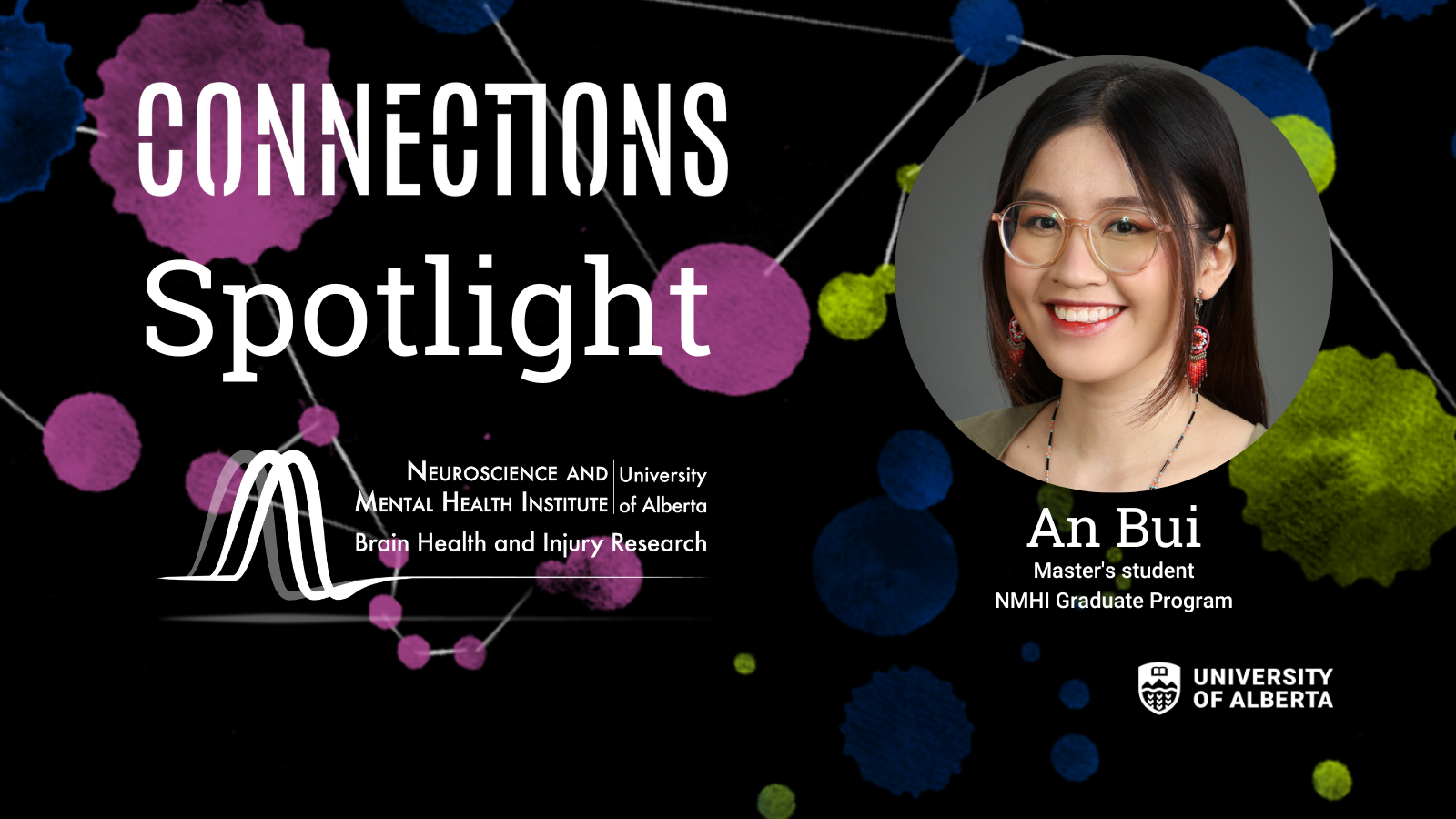CONNECTIONS Spotlight: An Bui
By Ramona Czakert Franson - 2 September 2022

Learn about An Bui, who is now a master’s student in the Neuroscience and Mental Health Institute graduate program, and her CONNECTIONS painting. An’s research focuses on improving patient recovery after stroke. CONNECTIONS, NMHI’s project that brings neuroscience and art together, inspired An to create her painting, A Beautiful Mind. We asked An about her work.
Tell us about your CONNECTIONS painting, A Beautiful Mind.
When I heard about CONNECTIONS, the first idea that came to my mind was, well, connections. There are so many ways connections are made in neuroscience, between different parts of the brain, between the brain and the rest of the body systems, and most importantly, between humans and humans (how their brains guide people to connect with one another). That was what I wanted to capture with my piece, as well as illustrate both the scientific and the artistic beauty of the brain. I wanted to break the connections down bit by bit, node by node, from the connections between the physician and the patient, between the patient herself and her brain, and between the neurons within her brain. I also wanted to highlight the sense of discovery when the physician connects with her patient as she was given the honour to look inside the patient’s brain, just to discover how beautiful, precious, and breathtaking the mind is (which I represented with the flowers and leaves of gold).

What is your work/research/studies about?
I have just started my master’s program in psychiatry with Dr. Winship after completing the undergraduate program in neuroscience. My research focuses on exploring how neutrophil stalls in the microvasculature contribute to poor clinical outcomes after stroke, both at the cellular and the transcriptional levels. Using microarray analysis, immunohistochemistry tests, and fluorescence imaging, we investigate how neutrophils behave before, during and after stroke. Understanding their dynamics can help us come up with strategies to minimize their deleterious effects and improve patient recovery after stroke. This is a continuation of my undergraduate thesis. I just completely fell in love with the project; there is so much more to learn and discover that I couldn’t get enough of it. So, I decided to pursue graduate studies and continue the project!
Why the University of Alberta and neuroscience?
I have always wanted to learn more about the brain and study neuroscience ever since high school. When I was looking at different universities to apply to, I saw that the University of Alberta offered a neuroscience program. The fact that the U of A is one of the highest-ranked research universities in Canada was the deciding factor. I love hands-on work, animal work, and work that requires preciseness and a high level of attention to detail which is also demonstrated in my art! Year after year of studying in the program, I cannot be more sure that I made the right decision. I am very fortunate to be studying and working with the most amazing colleagues in a field that is making real changes in the world.
Is the brain beautiful?
Absolutely. I think the very first “wow” moment for me was when I saw MRI images of the brain and realized that it is more beautiful than I had ever imagined. We know the brain is the most mysterious and complicated organ in the body, but seeing it physically, and how different structures unfold, each carrying very distinct functions, was unbelievable!
What is one thing you want people to understand better?
How much we have yet to learn about the brain. Despite how much progress we have made since the first drawing of the neuron by Santiago Ramón y Cajal, which was the central inspiration for my painting, there is still so much more. Research holds the power to improve the lives of so many people around the world, people with mental disorders, people with neurodegenerative disorders, children with developmental disorders, etc. So it is very important that we keep supporting and prioritizing neuroscience research, both basic and translational research. I hope that CONNECTIONS, like its name, will help people understand better how we, as a community, are very much connected to each other and rely on each other to function, just like the neurons in our brain, and that we should all support research in order to better the world we’re living in.
More about CONNECTIONS
Launched by the Neuroscience and Mental Health Institute (NMHI), in collaboration with the Faculty of Arts, CONNECTIONS is a project showcasing the relationship between art and neuroscience, portraying the many aspects of neuroscience, brain diseases and mental health in a creative and compelling way. Artists, scientists and persons with relevant lived experience were asked to submit artwork that related to this theme.
The NMHI is a multi-faculty, interdisciplinary teaching and research institute located at the University of Alberta. Our members come from medicine, pharmacy, science, rehabilitation medicine, kinesiology, psychology, nursing, business, engineering, computing science, arts, and more.
Aside from showcasing the relationship between art and neuroscience, the CONNECTIONS project will help to support research at the NMHI.
Follow NMHI’s Facebook and Twitter for posts that spotlight works from scientists and artists from many different departments and faculties at the U of A. And an on-demand book to purchase is coming soon!